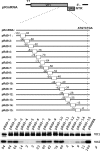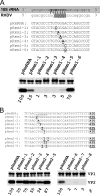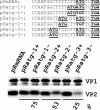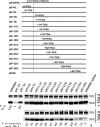Characterization of the sequence element directing translation reinitiation in RNA of the calicivirus rabbit hemorrhagic disease virus
- PMID: 17596308
- PMCID: PMC2045430
- DOI: 10.1128/JVI.00771-07
Characterization of the sequence element directing translation reinitiation in RNA of the calicivirus rabbit hemorrhagic disease virus
Abstract
The calicivirus minor capsid protein VP2 is expressed via reinitiation of protein synthesis after termination of translation of the preceding VP1 gene. A sequence element of about 80 nucleotides denoted "termination upstream ribosomal binding site" (TURBS) (25) is crucial for reinitiation. Deletion mapping in the TURBS of a rabbit calicivirus identified two short sequence motifs that were crucial for VP2 expression. Motif 1 is conserved among caliciviruses and is complementary to a sequence in the 18S rRNA. Single-residue exchanges in this motif severely impaired reinitiation when they affected the putative rRNA binding, whereas an exchange preserving complementarity had only a minor effect. Single exchanges in motif 2 were rather well tolerated, but the introduction of double exchanges almost blocked VP2 expression. In contrast, the deletion analyses showed that the RNA between the two motifs is of minor importance. The distance between motif 2 and the start site was found to be important, since deletions of increasing length in this sequence or upstream positioning of the start codon reduced VP2 expression stepwise to low levels, whereas multiple-nucleotide exchanges in this region were tolerated. The low flexibility of the arrangement of TURBS motif 2 and the start codon stand in marked contrast to the requirements with regard to the location of the stop codon of the preceding VP1 gene, which could be moved far downstream with continuous reduction, but without loss, of VP2 translation. The sequence mapping resulted in a refined model of the reinitiation mechanism leading to VP2 expression.
Figures








Similar articles
-
Expression of the VP2 protein of murine norovirus by a translation termination-reinitiation strategy.PLoS One. 2009 Dec 22;4(12):e8390. doi: 10.1371/journal.pone.0008390. PLoS One. 2009. PMID: 20027307 Free PMC article.
-
Two alternative ways of start site selection in human norovirus reinitiation of translation.J Biol Chem. 2014 Apr 25;289(17):11739-11754. doi: 10.1074/jbc.M114.554030. Epub 2014 Mar 5. J Biol Chem. 2014. PMID: 24599949 Free PMC article.
-
The importance of inter- and intramolecular base pairing for translation reinitiation on a eukaryotic bicistronic mRNA.Genes Dev. 2009 Feb 1;23(3):331-44. doi: 10.1101/gad.507609. Genes Dev. 2009. PMID: 19204118 Free PMC article.
-
Further characterisation of the translational termination-reinitiation signal of the influenza B virus segment 7 RNA.PLoS One. 2011 Feb 8;6(2):e16822. doi: 10.1371/journal.pone.0016822. PLoS One. 2011. PMID: 21347434 Free PMC article.
-
Translational termination-reinitiation in RNA viruses.Biochem Soc Trans. 2010 Dec;38(6):1558-64. doi: 10.1042/BST0381558. Biochem Soc Trans. 2010. PMID: 21118126 Review.
Cited by
-
Please do not recycle! Translation reinitiation in microbes and higher eukaryotes.FEMS Microbiol Rev. 2018 Mar 1;42(2):165-192. doi: 10.1093/femsre/fux059. FEMS Microbiol Rev. 2018. PMID: 29281028 Free PMC article. Review.
-
Characterization of the termination-reinitiation strategy employed in the expression of influenza B virus BM2 protein.RNA. 2008 Nov;14(11):2394-406. doi: 10.1261/rna.1231008. Epub 2008 Sep 29. RNA. 2008. PMID: 18824510 Free PMC article.
-
Novel Victorivirus from a Pakistani Isolate of Alternaria alternata Lacking a Typical Translational Stop/Restart Sequence Signature.Viruses. 2019 Jun 25;11(6):577. doi: 10.3390/v11060577. Viruses. 2019. PMID: 31242660 Free PMC article.
-
Expression of the VP2 protein of murine norovirus by a translation termination-reinitiation strategy.PLoS One. 2009 Dec 22;4(12):e8390. doi: 10.1371/journal.pone.0008390. PLoS One. 2009. PMID: 20027307 Free PMC article.
-
Dual short upstream open reading frames control translation of a herpesviral polycistronic mRNA.PLoS Pathog. 2013 Jan;9(1):e1003156. doi: 10.1371/journal.ppat.1003156. Epub 2013 Jan 31. PLoS Pathog. 2013. PMID: 23382684 Free PMC article.
References
-
- Adhin, M. R., and D. J. van Duin. 1990. Scanning model for translational reinitiation in eubacteria. J. Mol. Biol. 213:811-818. - PubMed
-
- Algire, M. A., and J. R. Lorsch. 2006. Where to begin? The mechanism of translation initiation codon selection in eukaryotes. Curr. Opin. Chem. Biol. 10:480-486. - PubMed
-
- Chaudhry, Y., A. Nayak, M. E. Bordeleau, J. Tanaka, J. Pelletier, G. J. Belsham, L. O. Roberts, and I. G. Goodfellow. 2006. Caliciviruses differ in their functional requirements for eIF4F components. J. Biol. Chem. 281:25315-25325. - PubMed
Publication types
MeSH terms
Substances
LinkOut - more resources
Full Text Sources

